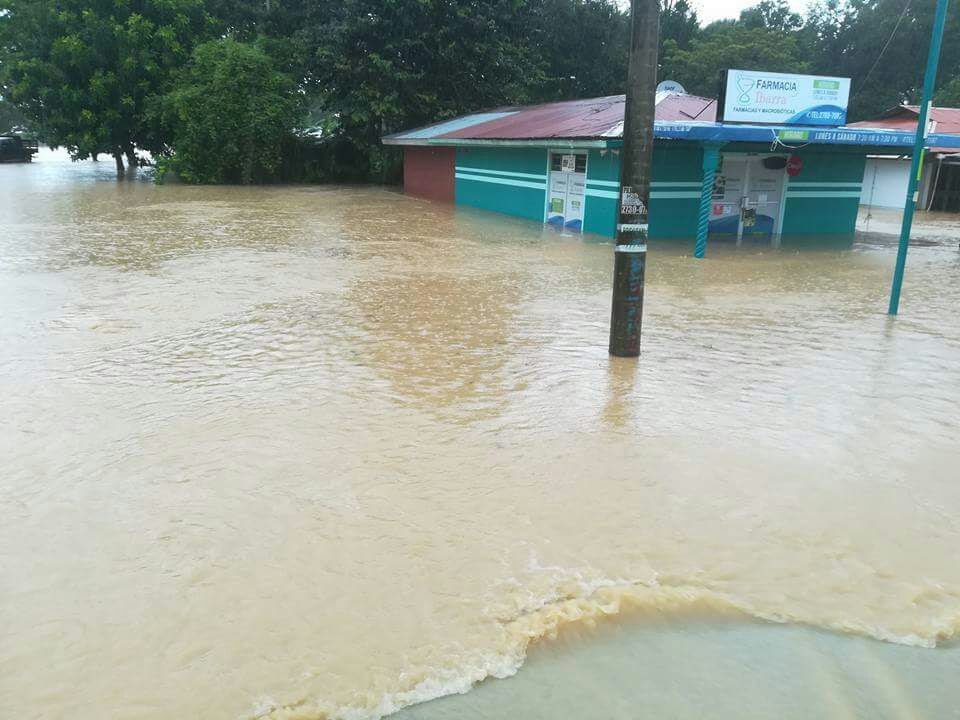Two things brought them together that day: the rain that was falling on everyone’s roofs, and the shared challenge of finding out how their communities prepare for disasters and emergencies. During a weekend of downpours and floods, landslides and shelters, the five journalists who created our July edition, “Watershed,” exchanged ideas via Zoom and WhatsApp. These inaugural members of El Colectivo 506’s new solutions journalism community, Network 506, talked about their experiences this month doing solutions journalism—most for the very first time—in rural communities.
Their comments were diverse, because although the rain and journalism united them, there is also much that differentiates them. They are children of cities and countryside, mothers and fathers, an assistant high school principal, a business administrator, experienced journalists and people who were encouraged by this project to write their first longform piece. All of them are daring, in one way or another, because they accepted the challenge that El Colectivo 506 proposed to them in May of this year: to head out into their communities to speak with mayors and volunteers and neighbors, to review detailed reports and data sets, all to understand how a community learns from its worst moments in the face of earthquakes and storms.
Katherine Benavides, in Bijagua de Upala; Esteban Calderón, in Uvita de Puntarenas; Alfonso Gatgens, in Sarapiquí, Heredia; Karina Méndez, in Monteverde, Puntarenas; and Mayela López, who reported on the communities of Talamanca, Limón, shared their learnings as journalists and citizens.
The luxury of extra time
Mayela, a journalist whose experience includes wire agencies and national newspapers, both of which demand short deadlines and breaking news coverage, highlighted what it means to be able to spend weeks with a single piece.
“This is a kind of journalism that allows you to dedicate more time and see different angles, speak with different actors,” said Mayela, who focused her report on the southeastern part of the country. “That is valuable and allows you to go deeper; that’s what differentiates it from what I have done before.”
“I’ll be honest with you: I was a little scared at first because I had never written, and I had never done solutions journalism,” says Esteban. “My work has been more audiovisual, personal interviews. I really like sports and politics… The first thing I learned is that it is not easy. It is not just anyone who can sit down and write an article.”
But for Esteban, as for his colleagues, his local connections were very helpful. This educator, soccer coach, and three-time president of his local development association was able to draw on a comprehensive network of contacts that allowed him to easily access information on flood response for his piece.
This was also true for Katherine, a former communicator for the Municipality of Upala; Karina, who has worked extensively with the leaders of the Monte Verde District; and Alfonso, who is part of Noticias Sarapiquí and therefore has constant contact with regional leaders and spokespeople. All three put their networks and contacts to work for the project. However, their focus on community-generated solutions, rather than the problems themselves, brought them unexpected lessons.
“I like solutions journalism because it’s not, ‘Why were so many houses destroyed by Nate?’ The important thing is how the community has worked after that to get ahead,” says Karina. “It’s not why it happened, but what was done as a result of that to have continuous improvement for the community… You learn that despite being a small community, when you go out to other places you are filled with pride by saying, ‘I come from here, and here it was done that way … I have always been very proud to say that I am from Monteverde, but when you do this kind of work, that grows even more.”
Challenges: synthesis and perseverance
Each of the five journalists highlights the difficulty of solutions journalism, echoing the same refrain: it’s not for everyone.
“I was very stressed, to be honest,” Katherine tells us. “I even dreamed about my reporting, because I wanted it to come out right… I like to have everything under control.”
The synthesis of large amounts of information was one of the most complex elements to handle, according to our participants. These reports seek to document the impact of a solution not from a single perspective, but from several: in this case, this meant national and municipal leaders, as well as community volunteers. This means that a wide range of interviews is necessary for a single story. What’s more, no interview is short, because journalists need to work with sources until they yield data to support their assertions and examine not only achievements, but also limitations of the actions taken.
As a result, each journalist sat down to write facing thousands of words and many hours of audio.
“You see all that material, and you say, ‘Now what do I do?’,” Mayela told us with a smile.
“The most difficult thing for me was to begin to synthesize the ideas,” says Esteban. “How do I get started? Several times I tried and told myself, no, not like this. Let me try again. That part of organizing ideas and saying, ‘This is where I’m going to start,’ was the hardest for me.”
As editors at El Colectivo 506, we watched them carry out this work while they balanced their day jobs (in some case, multiple day jobs) and other responsibilities.
“I wrote in the evenings after coming home from work and taking care of Lucia,” says Katherine, referring to her baby daughter.
For Karina, another challenge was learning to formulate her questions in such a way that people had to go beyond the complaint, and explore what had been done or what could be done to improve the situation.
“People sometimes tend to be a little negative. The first thing they tell you is the ugly part. In the case of Nate, the first thing is, ‘Oh, this poor family,’” she recalls. “You have to investigate more … so that the good comes out. What is being done now to resolve it? That was the challenge, to change that chip, because you have a slightly different perspective on the news. I had never done solutions journalism, so you have to ask the question more astutely to get the answers you need.”
Alfonso expressed frustration that his work will not reach more people.
“What I have realized is how difficult it is for people to read,” he says. “People today want things on a silver platter, so they would rather watch a video than read a 1500 word article.”
The rains continue
While these conversations were taking place on Saturday, July 24, we couldn’t help but point out that the kinds of emergencies these journalists reported on, far from being a distant memory, were happening again in Costa Rican communities at that very moment.
“It’s been a long night in Upala,” Katherine tells us. “Some houses have already been flooded, but not as much as Guatuso—there are photos of Guatuso that are very hard to look at. I’d say it’s like [Hurricane] Otto, more or less.”
She explained that the early warning sensor that figured in her report worked well during these rains, although a defect was detected: when the telecommunications signal goes out, the sensor can no longer be monitored remotely.
“It doesn’t generate ranges, nor meters, nor anything. So what they are doing is that there is a person there measuring on the bridge, right at the sensor,” she says.
For the population of these northern Costa Rican communities, which experienced an unexpected and unprecedented emergency during Hurricane Otto in 2916, the heavy rains raise fears.
“The people of Upala did not sleep at all,” Katherine says. “I have heard of people in downtown upala who live very close to the river, and every time it rains, they panic, because they’re the ones who get hit by the water,” Katherine tells us.
During that conversation, Alfonso was immersed in a new emergency in Sarapiquí, where rescue operations were active at the time of the call. At press time, we are working with him to incorporate the details of this new crisis into the report that Alfonso prepared for this issue, to be published this Friday.
With these new challenges all around them, the participating journalists say they feel even more eager to continue producing journalism that provides a useful service to communities.
“Finding solutions to a problem… allows us to give tools to other people that can help them solve a problem they are facing in their communities,” says Mayela. “That’s what I like the most about this kind of journalism. I feel like we are helping people as well. It’s not just saying, ‘Here’s a problem that’s taking place’ and leaving it there.”
For Katherine, it was rewarding to see how even her husband, who works for the municipality, learned new things from her reporting.
“He works at the Muni and he told me, ‘I didn’t know about the sensor,’” she says. “How cool that this kind of journalism allows one to learn a lot and also help people.”
“The experience was enriching because despite being from the area and knowing a lot about what happened with Tropical Storm Nate, I had to investigate more and learn more about the community where I live,” says Karina.
She adds that she plans to carry the lessons from this project into the future.
“That change of chip, changing the perspective and asking the right questions in an astute way, is what I learned. I sincerely believe that I will continue to apply it because for me it is extremely rewarding,” she says. “Why not keep going?”






